Reptiles of the World
Photo Shoot
This year's photo shoot featured 73 different subjects that we photographed, coming from three different sources for a variety of incredible images. Special thanks is extended to Chad Peeling from Clyde Peeling's Reptiland, an accredited zoo that specializes in displaying reptiles and amphibians, and my friends Gary Lee who supplied most of our venomous snakes, and especially to Dave Northcott, who drove in from California with a truck-full of reptiles, including treefrogs, geckos, aquatic turtles, and many colorful snakes and lizards.
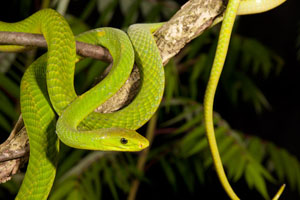
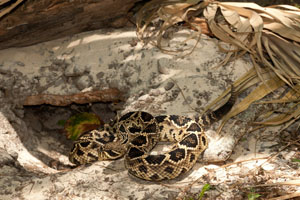
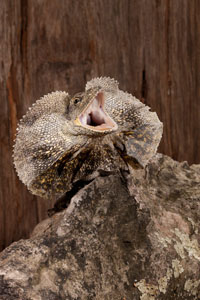

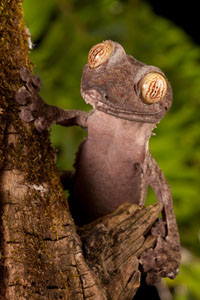
Green Mamba, Eastern Diamondback Rattlesnake, New Guinea Frilled Lizard, Red-eye treefrog, and Giant Leaf-tailed Gecko.
In all, we photographed 17 different species of venomous reptile, including gila monsters, green mambas, three species of cobras, and 7 species of rattlesnake. We did some great shooting with treefrogs, toads, and frogs, filming at least 17 different species, and some of the weirdest lizards, including at least 8 different geckos, frilled lizards, monitors, and chameleons.
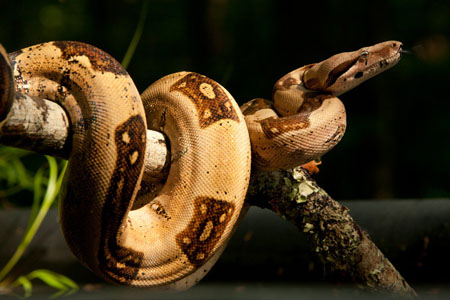
A boa constrictor filmed in natural light at our outdoor water set. For a few of our nonvenomous subjects filmed outdoors we could shoot natural light images while the principle photographer moved about, using our electronic flash setup.
Since only one participant shoots at a time, insuring everyone's safety when we're photographing venomous reptiles and guaranteeing that no one is compromised when getting a composition, certain shots end up to be unique. Perhaps the most interesting and amusing of these involved a Cottonmouth or water mocassin, a venomous snake found in SE USA that has a habit of gaping its mouth widely when disturbed, thus showing off its white 'cottony' interior. This threat display is meant to warn off predators. In the field, I've found this snake unsettling because a cottonmouth often holds its ground and simply gapes, showing its mouth, but giving no other warning of its presence. More than once I've almost rested my hand on a gaping cottonmouth perched on a cypress knee, or stepped upon one as I crossed a log. Luckily, in every case I saw the displaying snake before an accident occurred.
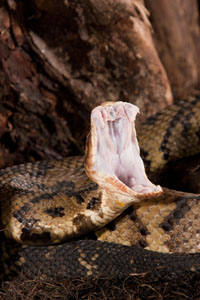 At any rate, one of our participants was 'up' to shoot when, without warning, the cottonmouth gaped its mouth widely. Fortunately, Tom was ready and he got the shot! We were all excited about the shot, and happy (and envious) of his luck, and everyone had renewed interest in getting more shots of the cottonmouth, hoping that it would gape again. We continued through our rotation until it was Tom's turn again, when, again without warning, the snake did it again! Tom got the shot a second time!
At any rate, one of our participants was 'up' to shoot when, without warning, the cottonmouth gaped its mouth widely. Fortunately, Tom was ready and he got the shot! We were all excited about the shot, and happy (and envious) of his luck, and everyone had renewed interest in getting more shots of the cottonmouth, hoping that it would gape again. We continued through our rotation until it was Tom's turn again, when, again without warning, the snake did it again! Tom got the shot a second time!
The shoot lasted for four days, starting at 9AM and continuing until 5PM, with some additional shooting after 7:30PM for an hour or two. We used both indoor and outdoor sets, with my outdoor sets including a 8x12 water set elevated off the ground, to provide near eye-level shots of a Siamese Crocodile, and another water set of 4x8 where we filmed the cottonmouth, canebrake rattlesnake, tree boas, and a few other subjects.

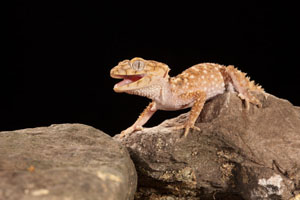
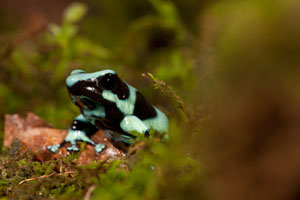
 c
c
Pakistani cobra, knobtailed gecko, and two species of Dart frog.
Indoors, we filmed another smaller water set, as well as all of our arboreal, jungle, desert, and woodland sets. All of our subjects were illuminated by our Dynalite electronic flashes, which were supported by Bogen Magic Arms mounted upon auto light poles. For some sets we used as many as a dozen Bogen arms, super clamps, and supports, but the results, I hope, provided a 'wild' and realistic look that was extremely authentic and true to the reptile or amphibian's natural habitat.
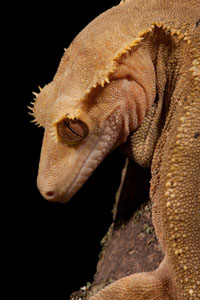
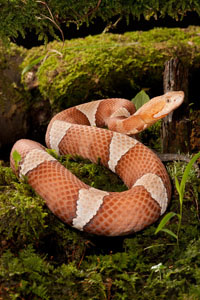



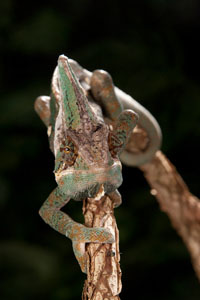
Crested Gecko, Trans Pecos Copperhead, Amazon Tree Boa, and two species of
treefrog, and a Veiled Chameleon.
To illustrate the concept of natural habitats, consider these two images of a Vietnamese Mossy Frog, one of the most cryptic, well camouflaged of all amphibians. We filmed it on a mossy log, and in the view on the left you can barely see the frog. The other view gives you an idea of what the frog looks like.
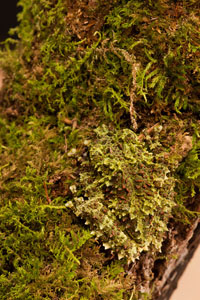
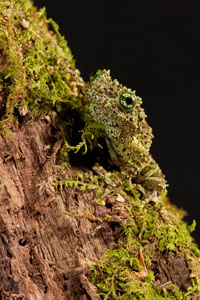
The links below will give you an idea of the variety of subjects we filmed. Check out our portfolio or that of Rich Miller, or our previous postings, all linked below.
Check out my portfolio of many of the subjects we did on shoot.
Check out the posted images of one of our participants, Rich Miller, for more views from this exciting shoot!
Contact our Office to REGISTER for this Photo Shoot which we may hold in 2011.
View a Reptiles of the World Portfolio
that illustrates subjects from previous shoots.
Return to HomePage or to photo tours general information.
Contact us by e-mail:info@hoothollow.com
Office Phone: 717 543-6423
Or FAX us at: (717) 543-5342.
Return to HomePage
Reptiles of the World
Photo Shoot
This year's photo shoot featured 73 different subjects that we photographed, coming from three different sources for a variety of incredible images. Special thanks is extended to Chad Peeling from Clyde Peeling's Reptiland, an accredited zoo that specializes in displaying reptiles and amphibians, and my friends Gary Lee who supplied most of our venomous snakes, and especially to Dave Northcott, who drove in from California with a truck-full of reptiles, including treefrogs, geckos, aquatic turtles, and many colorful snakes and lizards.





Green Mamba, Eastern Diamondback Rattlesnake, New Guinea Frilled Lizard, Red-eye treefrog, and Giant Leaf-tailed Gecko.
In all, we photographed 17 different species of venomous reptile, including gila monsters, green mambas, three species of cobras, and 7 species of rattlesnake. We did some great shooting with treefrogs, toads, and frogs, filming at least 17 different species, and some of the weirdest lizards, including at least 8 different geckos, frilled lizards, monitors, and chameleons.

A boa constrictor filmed in natural light at our outdoor water set. For a few of our nonvenomous subjects filmed outdoors we could shoot natural light images while the principle photographer moved about, using our electronic flash setup.
Since only one participant shoots at a time, insuring everyone's safety when we're photographing venomous reptiles and guaranteeing that no one is compromised when getting a composition, certain shots end up to be unique. Perhaps the most interesting and amusing of these involved a Cottonmouth or water mocassin, a venomous snake found in SE USA that has a habit of gaping its mouth widely when disturbed, thus showing off its white 'cottony' interior. This threat display is meant to warn off predators. In the field, I've found this snake unsettling because a cottonmouth often holds its ground and simply gapes, showing its mouth, but giving no other warning of its presence. More than once I've almost rested my hand on a gaping cottonmouth perched on a cypress knee, or stepped upon one as I crossed a log. Luckily, in every case I saw the displaying snake before an accident occurred.
 At any rate, one of our participants was 'up' to shoot when, without warning, the cottonmouth gaped its mouth widely. Fortunately, Tom was ready and he got the shot! We were all excited about the shot, and happy (and envious) of his luck, and everyone had renewed interest in getting more shots of the cottonmouth, hoping that it would gape again. We continued through our rotation until it was Tom's turn again, when, again without warning, the snake did it again! Tom got the shot a second time!
At any rate, one of our participants was 'up' to shoot when, without warning, the cottonmouth gaped its mouth widely. Fortunately, Tom was ready and he got the shot! We were all excited about the shot, and happy (and envious) of his luck, and everyone had renewed interest in getting more shots of the cottonmouth, hoping that it would gape again. We continued through our rotation until it was Tom's turn again, when, again without warning, the snake did it again! Tom got the shot a second time!
The shoot lasted for four days, starting at 9AM and continuing until 5PM, with some additional shooting after 7:30PM for an hour or two. We used both indoor and outdoor sets, with my outdoor sets including a 8x12 water set elevated off the ground, to provide near eye-level shots of a Siamese Crocodile, and another water set of 4x8 where we filmed the cottonmouth, canebrake rattlesnake, tree boas, and a few other subjects.



 c
c
Pakistani cobra, knobtailed gecko, and two species of Dart frog.
Indoors, we filmed another smaller water set, as well as all of our arboreal, jungle, desert, and woodland sets. All of our subjects were illuminated by our Dynalite electronic flashes, which were supported by Bogen Magic Arms mounted upon auto light poles. For some sets we used as many as a dozen Bogen arms, super clamps, and supports, but the results, I hope, provided a 'wild' and realistic look that was extremely authentic and true to the reptile or amphibian's natural habitat.






Crested Gecko, Trans Pecos Copperhead, Amazon Tree Boa, and two species of
treefrog, and a Veiled Chameleon.
To illustrate the concept of natural habitats, consider these two images of a Vietnamese Mossy Frog, one of the most cryptic, well camouflaged of all amphibians. We filmed it on a mossy log, and in the view on the left you can barely see the frog. The other view gives you an idea of what the frog looks like.


The links below will give you an idea of the variety of subjects we filmed. Check out our portfolio or that of Rich Miller, or our previous postings, all linked below.
Check out my portfolio of many of the subjects we did on shoot.
Check out the posted images of one of our participants, Rich Miller, for more views from this exciting shoot!
Contact our Office to REGISTER for this Photo Shoot which we may hold in 2011.
View a Reptiles of the World Portfolio
that illustrates subjects from previous shoots.
Return to HomePage or to photo tours general information.
Contact us by e-mail:info@hoothollow.com
Office Phone: 717 543-6423
Or FAX us at: (717) 543-5342.
Return to HomePage
Reptiles of the World
Photo Shoot
This year's photo shoot featured 73 different subjects that we photographed, coming from three different sources for a variety of incredible images. Special thanks is extended to Chad Peeling from Clyde Peeling's Reptiland, an accredited zoo that specializes in displaying reptiles and amphibians, and my friends Gary Lee who supplied most of our venomous snakes, and especially to Dave Northcott, who drove in from California with a truck-full of reptiles, including treefrogs, geckos, aquatic turtles, and many colorful snakes and lizards.





Green Mamba, Eastern Diamondback Rattlesnake, New Guinea Frilled Lizard, Red-eye treefrog, and Giant Leaf-tailed Gecko.
In all, we photographed 17 different species of venomous reptile, including gila monsters, green mambas, three species of cobras, and 7 species of rattlesnake. We did some great shooting with treefrogs, toads, and frogs, filming at least 17 different species, and some of the weirdest lizards, including at least 8 different geckos, frilled lizards, monitors, and chameleons.

A boa constrictor filmed in natural light at our outdoor water set. For a few of our nonvenomous subjects filmed outdoors we could shoot natural light images while the principle photographer moved about, using our electronic flash setup.
Since only one participant shoots at a time, insuring everyone's safety when we're photographing venomous reptiles and guaranteeing that no one is compromised when getting a composition, certain shots end up to be unique. Perhaps the most interesting and amusing of these involved a Cottonmouth or water mocassin, a venomous snake found in SE USA that has a habit of gaping its mouth widely when disturbed, thus showing off its white 'cottony' interior. This threat display is meant to warn off predators. In the field, I've found this snake unsettling because a cottonmouth often holds its ground and simply gapes, showing its mouth, but giving no other warning of its presence. More than once I've almost rested my hand on a gaping cottonmouth perched on a cypress knee, or stepped upon one as I crossed a log. Luckily, in every case I saw the displaying snake before an accident occurred.
 At any rate, one of our participants was 'up' to shoot when, without warning, the cottonmouth gaped its mouth widely. Fortunately, Tom was ready and he got the shot! We were all excited about the shot, and happy (and envious) of his luck, and everyone had renewed interest in getting more shots of the cottonmouth, hoping that it would gape again. We continued through our rotation until it was Tom's turn again, when, again without warning, the snake did it again! Tom got the shot a second time!
At any rate, one of our participants was 'up' to shoot when, without warning, the cottonmouth gaped its mouth widely. Fortunately, Tom was ready and he got the shot! We were all excited about the shot, and happy (and envious) of his luck, and everyone had renewed interest in getting more shots of the cottonmouth, hoping that it would gape again. We continued through our rotation until it was Tom's turn again, when, again without warning, the snake did it again! Tom got the shot a second time!
The shoot lasted for four days, starting at 9AM and continuing until 5PM, with some additional shooting after 7:30PM for an hour or two. We used both indoor and outdoor sets, with my outdoor sets including a 8x12 water set elevated off the ground, to provide near eye-level shots of a Siamese Crocodile, and another water set of 4x8 where we filmed the cottonmouth, canebrake rattlesnake, tree boas, and a few other subjects.



 c
c
Pakistani cobra, knobtailed gecko, and two species of Dart frog.
Indoors, we filmed another smaller water set, as well as all of our arboreal, jungle, desert, and woodland sets. All of our subjects were illuminated by our Dynalite electronic flashes, which were supported by Bogen Magic Arms mounted upon auto light poles. For some sets we used as many as a dozen Bogen arms, super clamps, and supports, but the results, I hope, provided a 'wild' and realistic look that was extremely authentic and true to the reptile or amphibian's natural habitat.






Crested Gecko, Trans Pecos Copperhead, Amazon Tree Boa, and two species of
treefrog, and a Veiled Chameleon.
To illustrate the concept of natural habitats, consider these two images of a Vietnamese Mossy Frog, one of the most cryptic, well camouflaged of all amphibians. We filmed it on a mossy log, and in the view on the left you can barely see the frog. The other view gives you an idea of what the frog looks like.


The links below will give you an idea of the variety of subjects we filmed. Check out our portfolio or that of Rich Miller, or our previous postings, all linked below.
Check out my portfolio of many of the subjects we did on shoot.
Check out the posted images of one of our participants, Rich Miller, for more views from this exciting shoot!
Contact our Office to REGISTER for this Photo Shoot which we may hold in 2011.
View a Reptiles of the World Portfolio
that illustrates subjects from previous shoots.
Return to HomePage or to photo tours general information.
Contact us by e-mail:info@hoothollow.com
Office Phone: 717 543-6423
Or FAX us at: (717) 543-5342.
Return to HomePage
Reptiles of the World
Photo Shoot
This year's photo shoot featured 73 different subjects that we photographed, coming from three different sources for a variety of incredible images. Special thanks is extended to Chad Peeling from Clyde Peeling's Reptiland, an accredited zoo that specializes in displaying reptiles and amphibians, and my friends Gary Lee who supplied most of our venomous snakes, and especially to Dave Northcott, who drove in from California with a truck-full of reptiles, including treefrogs, geckos, aquatic turtles, and many colorful snakes and lizards.





Green Mamba, Eastern Diamondback Rattlesnake, New Guinea Frilled Lizard, Red-eye treefrog, and Giant Leaf-tailed Gecko.
In all, we photographed 17 different species of venomous reptile, including gila monsters, green mambas, three species of cobras, and 7 species of rattlesnake. We did some great shooting with treefrogs, toads, and frogs, filming at least 17 different species, and some of the weirdest lizards, including at least 8 different geckos, frilled lizards, monitors, and chameleons.

A boa constrictor filmed in natural light at our outdoor water set. For a few of our nonvenomous subjects filmed outdoors we could shoot natural light images while the principle photographer moved about, using our electronic flash setup.
Since only one participant shoots at a time, insuring everyone's safety when we're photographing venomous reptiles and guaranteeing that no one is compromised when getting a composition, certain shots end up to be unique. Perhaps the most interesting and amusing of these involved a Cottonmouth or water mocassin, a venomous snake found in SE USA that has a habit of gaping its mouth widely when disturbed, thus showing off its white 'cottony' interior. This threat display is meant to warn off predators. In the field, I've found this snake unsettling because a cottonmouth often holds its ground and simply gapes, showing its mouth, but giving no other warning of its presence. More than once I've almost rested my hand on a gaping cottonmouth perched on a cypress knee, or stepped upon one as I crossed a log. Luckily, in every case I saw the displaying snake before an accident occurred.
 At any rate, one of our participants was 'up' to shoot when, without warning, the cottonmouth gaped its mouth widely. Fortunately, Tom was ready and he got the shot! We were all excited about the shot, and happy (and envious) of his luck, and everyone had renewed interest in getting more shots of the cottonmouth, hoping that it would gape again. We continued through our rotation until it was Tom's turn again, when, again without warning, the snake did it again! Tom got the shot a second time!
At any rate, one of our participants was 'up' to shoot when, without warning, the cottonmouth gaped its mouth widely. Fortunately, Tom was ready and he got the shot! We were all excited about the shot, and happy (and envious) of his luck, and everyone had renewed interest in getting more shots of the cottonmouth, hoping that it would gape again. We continued through our rotation until it was Tom's turn again, when, again without warning, the snake did it again! Tom got the shot a second time!
The shoot lasted for four days, starting at 9AM and continuing until 5PM, with some additional shooting after 7:30PM for an hour or two. We used both indoor and outdoor sets, with my outdoor sets including a 8x12 water set elevated off the ground, to provide near eye-level shots of a Siamese Crocodile, and another water set of 4x8 where we filmed the cottonmouth, canebrake rattlesnake, tree boas, and a few other subjects.



 c
c
Pakistani cobra, knobtailed gecko, and two species of Dart frog.
Indoors, we filmed another smaller water set, as well as all of our arboreal, jungle, desert, and woodland sets. All of our subjects were illuminated by our Dynalite electronic flashes, which were supported by Bogen Magic Arms mounted upon auto light poles. For some sets we used as many as a dozen Bogen arms, super clamps, and supports, but the results, I hope, provided a 'wild' and realistic look that was extremely authentic and true to the reptile or amphibian's natural habitat.






Crested Gecko, Trans Pecos Copperhead, Amazon Tree Boa, and two species of
treefrog, and a Veiled Chameleon.
To illustrate the concept of natural habitats, consider these two images of a Vietnamese Mossy Frog, one of the most cryptic, well camouflaged of all amphibians. We filmed it on a mossy log, and in the view on the left you can barely see the frog. The other view gives you an idea of what the frog looks like.


The links below will give you an idea of the variety of subjects we filmed. Check out our portfolio or that of Rich Miller, or our previous postings, all linked below.
Check out my portfolio of many of the subjects we did on shoot.
Check out the posted images of one of our participants, Rich Miller, for more views from this exciting shoot!
Contact our Office to REGISTER for this Photo Shoot which we may hold in 2011.
View a Reptiles of the World Portfolio
that illustrates subjects from previous shoots.
Return to HomePage or to photo tours general information.
Contact us by e-mail:info@hoothollow.com
Office Phone: 717 543-6423
Or FAX us at: (717) 543-5342.
Return to HomePage
Reptiles of the World
Photo Shoot
This year's photo shoot featured 73 different subjects that we photographed, coming from three different sources for a variety of incredible images. Special thanks is extended to Chad Peeling from Clyde Peeling's Reptiland, an accredited zoo that specializes in displaying reptiles and amphibians, and my friends Gary Lee who supplied most of our venomous snakes, and especially to Dave Northcott, who drove in from California with a truck-full of reptiles, including treefrogs, geckos, aquatic turtles, and many colorful snakes and lizards.





Green Mamba, Eastern Diamondback Rattlesnake, New Guinea Frilled Lizard, Red-eye treefrog, and Giant Leaf-tailed Gecko.
In all, we photographed 17 different species of venomous reptile, including gila monsters, green mambas, three species of cobras, and 7 species of rattlesnake. We did some great shooting with treefrogs, toads, and frogs, filming at least 17 different species, and some of the weirdest lizards, including at least 8 different geckos, frilled lizards, monitors, and chameleons.

A boa constrictor filmed in natural light at our outdoor water set. For a few of our nonvenomous subjects filmed outdoors we could shoot natural light images while the principle photographer moved about, using our electronic flash setup.
Since only one participant shoots at a time, insuring everyone's safety when we're photographing venomous reptiles and guaranteeing that no one is compromised when getting a composition, certain shots end up to be unique. Perhaps the most interesting and amusing of these involved a Cottonmouth or water mocassin, a venomous snake found in SE USA that has a habit of gaping its mouth widely when disturbed, thus showing off its white 'cottony' interior. This threat display is meant to warn off predators. In the field, I've found this snake unsettling because a cottonmouth often holds its ground and simply gapes, showing its mouth, but giving no other warning of its presence. More than once I've almost rested my hand on a gaping cottonmouth perched on a cypress knee, or stepped upon one as I crossed a log. Luckily, in every case I saw the displaying snake before an accident occurred.
 At any rate, one of our participants was 'up' to shoot when, without warning, the cottonmouth gaped its mouth widely. Fortunately, Tom was ready and he got the shot! We were all excited about the shot, and happy (and envious) of his luck, and everyone had renewed interest in getting more shots of the cottonmouth, hoping that it would gape again. We continued through our rotation until it was Tom's turn again, when, again without warning, the snake did it again! Tom got the shot a second time!
At any rate, one of our participants was 'up' to shoot when, without warning, the cottonmouth gaped its mouth widely. Fortunately, Tom was ready and he got the shot! We were all excited about the shot, and happy (and envious) of his luck, and everyone had renewed interest in getting more shots of the cottonmouth, hoping that it would gape again. We continued through our rotation until it was Tom's turn again, when, again without warning, the snake did it again! Tom got the shot a second time!
The shoot lasted for four days, starting at 9AM and continuing until 5PM, with some additional shooting after 7:30PM for an hour or two. We used both indoor and outdoor sets, with my outdoor sets including a 8x12 water set elevated off the ground, to provide near eye-level shots of a Siamese Crocodile, and another water set of 4x8 where we filmed the cottonmouth, canebrake rattlesnake, tree boas, and a few other subjects.



 c
c
Pakistani cobra, knobtailed gecko, and two species of Dart frog.
Indoors, we filmed another smaller water set, as well as all of our arboreal, jungle, desert, and woodland sets. All of our subjects were illuminated by our Dynalite electronic flashes, which were supported by Bogen Magic Arms mounted upon auto light poles. For some sets we used as many as a dozen Bogen arms, super clamps, and supports, but the results, I hope, provided a 'wild' and realistic look that was extremely authentic and true to the reptile or amphibian's natural habitat.






Crested Gecko, Trans Pecos Copperhead, Amazon Tree Boa, and two species of
treefrog, and a Veiled Chameleon.
To illustrate the concept of natural habitats, consider these two images of a Vietnamese Mossy Frog, one of the most cryptic, well camouflaged of all amphibians. We filmed it on a mossy log, and in the view on the left you can barely see the frog. The other view gives you an idea of what the frog looks like.


The links below will give you an idea of the variety of subjects we filmed. Check out our portfolio or that of Rich Miller, or our previous postings, all linked below.
Check out my portfolio of many of the subjects we did on shoot.
Check out the posted images of one of our participants, Rich Miller, for more views from this exciting shoot!
Reptiles of the World
Photo Shoot
This year's photo shoot featured 73 different subjects that we photographed, coming from three different sources for a variety of incredible images. Special thanks is extended to Chad Peeling from Clyde Peeling's Reptiland, an accredited zoo that specializes in displaying reptiles and amphibians, and my friends Gary Lee who supplied most of our venomous snakes, and especially to Dave Northcott, who drove in from California with a truck-full of reptiles, including treefrogs, geckos, aquatic turtles, and many colorful snakes and lizards.





Green Mamba, Eastern Diamondback Rattlesnake, New Guinea Frilled Lizard, Red-eye treefrog, and Giant Leaf-tailed Gecko.
In all, we photographed 17 different species of venomous reptile, including gila monsters, green mambas, three species of cobras, and 7 species of rattlesnake. We did some great shooting with treefrogs, toads, and frogs, filming at least 17 different species, and some of the weirdest lizards, including at least 8 different geckos, frilled lizards, monitors, and chameleons.

A boa constrictor filmed in natural light at our outdoor water set. For a few of our nonvenomous subjects filmed outdoors we could shoot natural light images while the principle photographer moved about, using our electronic flash setup.
Since only one participant shoots at a time, insuring everyone's safety when we're photographing venomous reptiles and guaranteeing that no one is compromised when getting a composition, certain shots end up to be unique. Perhaps the most interesting and amusing of these involved a Cottonmouth or water mocassin, a venomous snake found in SE USA that has a habit of gaping its mouth widely when disturbed, thus showing off its white 'cottony' interior. This threat display is meant to warn off predators. In the field, I've found this snake unsettling because a cottonmouth often holds its ground and simply gapes, showing its mouth, but giving no other warning of its presence. More than once I've almost rested my hand on a gaping cottonmouth perched on a cypress knee, or stepped upon one as I crossed a log. Luckily, in every case I saw the displaying snake before an accident occurred.
 At any rate, one of our participants was 'up' to shoot when, without warning, the cottonmouth gaped its mouth widely. Fortunately, Tom was ready and he got the shot! We were all excited about the shot, and happy (and envious) of his luck, and everyone had renewed interest in getting more shots of the cottonmouth, hoping that it would gape again. We continued through our rotation until it was Tom's turn again, when, again without warning, the snake did it again! Tom got the shot a second time!
At any rate, one of our participants was 'up' to shoot when, without warning, the cottonmouth gaped its mouth widely. Fortunately, Tom was ready and he got the shot! We were all excited about the shot, and happy (and envious) of his luck, and everyone had renewed interest in getting more shots of the cottonmouth, hoping that it would gape again. We continued through our rotation until it was Tom's turn again, when, again without warning, the snake did it again! Tom got the shot a second time!
The shoot lasted for four days, starting at 9AM and continuing until 5PM, with some additional shooting after 7:30PM for an hour or two. We used both indoor and outdoor sets, with my outdoor sets including a 8x12 water set elevated off the ground, to provide near eye-level shots of a Siamese Crocodile, and another water set of 4x8 where we filmed the cottonmouth, canebrake rattlesnake, tree boas, and a few other subjects.



 c
c
Pakistani cobra, knobtailed gecko, and two species of Dart frog.
Indoors, we filmed another smaller water set, as well as all of our arboreal, jungle, desert, and woodland sets. All of our subjects were illuminated by our Dynalite electronic flashes, which were supported by Bogen Magic Arms mounted upon auto light poles. For some sets we used as many as a dozen Bogen arms, super clamps, and supports, but the results, I hope, provided a 'wild' and realistic look that was extremely authentic and true to the reptile or amphibian's natural habitat.






Crested Gecko, Trans Pecos Copperhead, Amazon Tree Boa, and two species of
treefrog, and a Veiled Chameleon.
To illustrate the concept of natural habitats, consider these two images of a Vietnamese Mossy Frog, one of the most cryptic, well camouflaged of all amphibians. We filmed it on a mossy log, and in the view on the left you can barely see the frog. The other view gives you an idea of what the frog looks like.


The links below will give you an idea of the variety of subjects we filmed. Check out our portfolio or that of Rich Miller, or our previous postings, all linked below.
Check out my portfolio of many of the subjects we did on shoot.
Check out the posted images of one of our participants, Rich Miller, for more views from this exciting shoot!
Contact our Office to REGISTER for this Photo Shoot which we may hold in 2011.
View a Reptiles of the World Portfolio
that illustrates subjects from previous shoots.
Return to HomePage or to photo tours general information.
Contact our Office to REGISTER for this Photo Shoot which we may hold in 2011.
Contact our Office to REGISTER for this Photo Shoot which we may hold in 2011.
View a Reptiles of the World Portfolio
that illustrates subjects from previous shoots.
View a Reptiles of the World Portfolio that illustrates subjects from previous shoots.
Return to HomePage or to photo tours general information.
Office Phone: 717 543-6423
Or FAX us at: (717) 543-5342.


